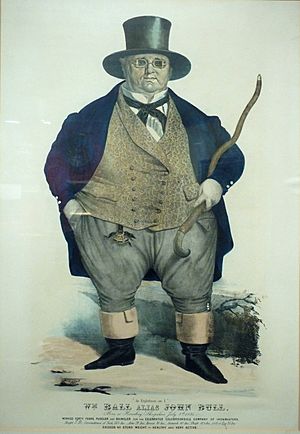William Ball (Shropshire Giant) facts for kids
Quick facts for kids
William Ball
|
|
|---|---|

A lithographic print at the Museum of the Gorge, Ironbridge
|
|
| Born | June 1795 |
| Died | June 1852 (aged 57) |
| Burial place | St Luke's Church, Doseley |
| Nationality | English |
| Other names |
|
| Occupation | Iron puddler and shingler |
| Employer | Coalbrookdale Company |
| Known for | His great size, weight and strength |
| Height | 5 ft 9 in (1.75 m) |
| Spouse(s) |
|
| Children |
|
| Parent(s) | Thomas and Elizabeth Ball |
William Ball (1795–1852), also known as Billy Ball or the "Shropshire Giant", was a very large and strong man from the 1800s. He worked with iron and was famous for his amazing size.
Billy Ball was born in June 1795 in a place called Horsehay, which is in Shropshire, England. He lived in Horsehay his whole life. We don't know his exact birthday, but he was baptised on July 8th. He was the first of five children born to Thomas and Elizabeth Ball.
When he grew up, Billy Ball was about 5 feet 9 inches (1.75 m) tall. He weighed more than 40 stone, which is over 250 kilograms! People said his waistcoat (a type of vest) was so big that three grown men could fit inside it.
In 1819, when he was 24, Billy Ball married Mary Bailey. They had two children, Eliza and Thomas. Sadly, both his wife and daughter died in 1824. His son, Thomas, also passed away young at the age of fifteen. In 1825, Billy Ball married Margaret Wood. They did not have any children together. People in his town knew him as a happy and kind man.
Contents
Working with Iron
Billy Ball started working at the Coalbrookdale Company's Horsehay Ironworks when he was only eight years old. He worked there for 40 years until 1843. His main jobs were being a puddler and a shingler.
- A puddler was a person who stirred hot, melted iron to make it stronger. This job needed a lot of skill and incredible physical strength.
- A shingler was someone who shaped the hot iron after it had been puddled.
Because he was so strong, "Big Billy Ball" was perfect for these jobs. There's a story that he once lifted a piece of iron weighing almost 9 long hundredweight (460 kg; 1,000 lb) by himself! He put it under a huge hammer at the ironworks. In 1841, he was listed as a forgeman, which is another type of ironworker.
In 1843, Billy Ball had an accident. A piece of hot, melted iron flew into his eye, and he became blind in that eye. After this, he always wore special glass goggles. He also stopped working at the ironworks because of his injury.
The Shropshire Giant
After leaving the ironworks, Billy Ball started showing himself at different county fairs. He called himself "The Largest Man in Britain" and used the stage name 'John Bull'.
In 1850, a special event took place to celebrate the birth of Alfred Darby II, who was from the famous Darby family that owned the ironworks. Billy Ball was chosen to lead a parade on horseback. He rode alongside 'Little Bennie Poole', who was the smallest man working at the Coalbrookdale Company, riding a pony. Because Billy Ball was so big, workers had to use a special lifting tool called a block and tackle to get him onto his horse. He even joked, "Dunno yo drop me!" Sadly, the horse was so hurt after carrying him that it had to be put down.
In 1851, a census (a count of people) listed him, but it didn't say what his job was.
Visiting The Great Exhibition
Billy Ball was invited to The Great Exhibition in London in 1851. This was a huge event that showed off new inventions and art from around the world. He was invited as both a special guest and a celebrity to be seen. The train seats weren't big enough for him, so he had to travel in the train's special storage area called the guard's van. This was his last big public appearance.
Some businessmen in Birmingham tried to tease him about his size. They asked him how much fabric and money it would take to make him a suit. Billy Ball quickly replied that if they would take him to a tailor, have him measured, and pay for the suit, he would tell them. After that, they left him alone!
Billy Ball didn't enjoy his time in London very much. He was even targeted by thieves. He left London hoping never to return and decided he didn't want to travel far from Horsehay again.
His Final Years
Billy Ball passed away in June 1852, the year after his trip to The Great Exhibition. He was 57 years old.
When he died, he was so large that his coffin couldn't fit through the door of his home in Sandy Bank Row, Horsehay. Workers had to remove a window and some bricks around it to get him out. It took ten strong men, using straps and poles, to carry his coffin. People said the coffin was so big that "ten lads were able to lie in it." Even though many people came to his funeral at St Luke's Church in Doseley, he was buried in a grave without a headstone.
See also
- Daniel Lambert (1770–1809)

